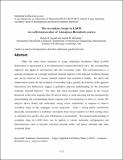| dc.contributor.author | Ewoldt, Randy H. | |
| dc.contributor.author | McKinley, Gareth H | |
| dc.date.accessioned | 2013-09-25T19:49:46Z | |
| dc.date.available | 2013-09-25T19:49:46Z | |
| dc.date.issued | 2009-12 | |
| dc.identifier.issn | 0035-4511 | |
| dc.identifier.issn | 1435-1528 | |
| dc.identifier.uri | http://hdl.handle.net/1721.1/81182 | |
| dc.description.abstract | When the shear stress measured in large amplitude oscillatory shear (LAOS) deformation is represented as a 2-D Lissajous–Bowditch curve, the corresponding trajectory can appear to self-intersect and form secondary loops. This self-intersection is a general consequence of a strongly nonlinear material response to the imposed oscillatory forcing and can be observed for various material systems and constitutive models. We derive the mathematical criteria for the formation of secondary loops, quantify the location of the apparent intersection, and furthermore suggest a qualitative physical understanding for the associated nonlinear material behavior. We show that when secondary loops appear in the viscous projection of the stress response (the 2-D plot of stress vs. strain rate), they are best interpreted by understanding the corresponding elastic response (the 2-D projection of stress vs. strain). The analysis shows clearly that sufficiently strong elastic nonlinearity is required to observe secondary loops on the conjugate viscous projection. Such a strong elastic nonlinearity physically corresponds to a nonlinear viscoelastic shear stress overshoot in which existing stress is unloaded more quickly than new deformation is accumulated. This general understanding of secondary loops in LAOS flows can be applied to various molecular configurations and microstructures such as polymer solutions, polymer melts, soft glassy materials, and other structured fluids. | en_US |
| dc.language.iso | en_US | |
| dc.publisher | Springer-Verlag | en_US |
| dc.relation.isversionof | http://dx.doi.org/10.1007/s00397-009-0408-2 | en_US |
| dc.rights | Creative Commons Attribution-Noncommercial-Share Alike 3.0 | en_US |
| dc.rights.uri | http://creativecommons.org/licenses/by-nc-sa/3.0/ | en_US |
| dc.source | MIT web domain | en_US |
| dc.title | On secondary loops in LAOS via self-intersection of Lissajous–Bowditch curves | en_US |
| dc.type | Article | en_US |
| dc.identifier.citation | Ewoldt, Randy H., and Gareth H. McKinley. On Secondary Loops in LAOS via Self-intersection of Lissajous–Bowditch Curves. Rheologica Acta 49, no. 2 (February 12, 2010): 213-219. | en_US |
| dc.contributor.department | Massachusetts Institute of Technology. Department of Mechanical Engineering | en_US |
| dc.contributor.department | Massachusetts Institute of Technology. Hatsopoulos Microfluids Laboratory | en_US |
| dc.contributor.mitauthor | Ewoldt, Randy H. | en_US |
| dc.contributor.mitauthor | McKinley, Gareth H. | en_US |
| dc.relation.journal | Rheologica Acta | en_US |
| dc.eprint.version | Author's final manuscript | en_US |
| dc.type.uri | http://purl.org/eprint/type/JournalArticle | en_US |
| eprint.status | http://purl.org/eprint/status/PeerReviewed | en_US |
| dspace.orderedauthors | Ewoldt, Randy H.; McKinley, Gareth H. | en_US |
| dc.identifier.orcid | https://orcid.org/0000-0001-8323-2779 | |
| mit.license | OPEN_ACCESS_POLICY | en_US |
| mit.metadata.status | Complete | |
